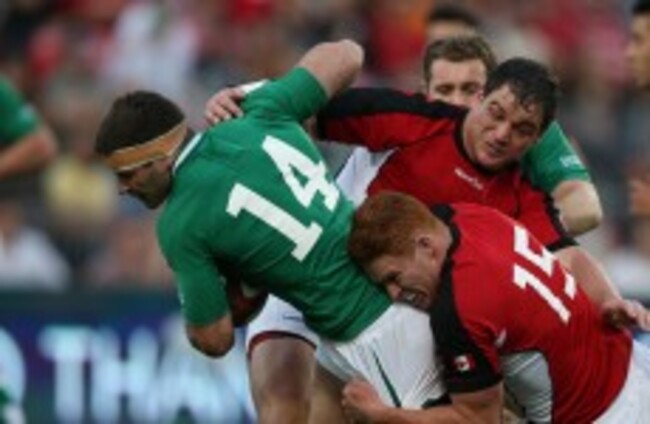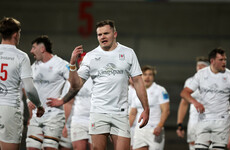Originally posted 08.45
LESS THAN 20 years into professionalism, rugby has become extremely open-minded to technology and sports science. Indeed, in many regards, it is leading the way.
One example of that is the use of the GPS and heart rate monitoring systems provided by firms like STATSports, who are based in Dundalk. Formed in 2007 by Seán O’Connor and Alan Clarke, the company now provides its Viper system to the IRFU, Ulster Rugby and Connacht, as well as 15 of the 20 Premier League clubs in English soccer and the likes of Barcelona and Juventus.
Other clients in rugby include the RFU, Super Rugby champions the Chiefs, Saracens, Leicester Tigers and Harlequins. STATSports analyst Richard Moffett joined TheScore.ie to explain the workings of the technology and what kind of data rugby clubs are focusing on.
At the very heart of the system is the Viper Pod, the matchbox-sized capsule that you may have noticed on the upper back of many rugby players. The pod weighs about the same as two AA batteries, but manages to pack heaps of technology into its miniature frame. Teams can wear the pod in a tight vest or in the small pocket now built into many jersey designs.
The second part of equipment the players wear is a thin hart-rate monitor that goes around the chest. Information collected by the two elements can be download by connection to a docking station, but can also be viewed live while a game or training session takes place.
The live feeds can assist coaches with in-game decisions and substitutions, but when the data is downloaded post-match, more in-depth analysis can be done. So what exactly is the point of using the system? What does this technology tell coaches and players?
When STATSports first launched in 2007 many clients simply wanted to know what distance their players were covering in games. ‘The higher, the better’ was the consensus but clubs gradually realised that how far a player runs isn’t as important as what he or she does in that distance. The focus shifted towards ‘high speed running’ measurements, recording how many metres a player covers over a specific speed.
Different players have different speeds to surpass in order to get into the high speed metres category, with a highly individualized approach to this aspect of the data. There are six different speed zones for every player, completely relative to his or her own max speed. That would mean, for example, that a winger’s ‘zone six’ speed measurement would be higher than a prop’s.

The Viper pod slips into this small pocket in the player's jersey. ©INPHO/Billy Stickland.
So what about the players who don't get to those high speed zones very often? A scrum-half is the perfect example, a player who accelerates and decelerates constantly as they move from ruck to ruck. Unlike a winger, they may not get a chance to stretch their legs in open field, but they're still working hard. The GPS system can account for their hard work with the HML (high metabolic load) distance measurement.
The HML distance records the metres a player covers while accelerating and decelerating at high intensity. Moffett's analogy is a car breaking and accelerating on poor roads and, despite never reaching high speeds, using lots of fuel. Another car could travel at 100 km/h for an extended time without using much fuel at all. The HML measurement gives credit to the first car, the guy who is working hard in tight areas.
The heart rate monitor is a particular area of interest for many clubs, with a max heart rate established in fitness testing at the start of the season. That allows the analysts to record how much of a game or training session players spend in the 'red zone', above 85% of their max heart rate. Again, it's a good indicator of effort.
A built-in accelerometer allows coaches and players to see the intensity of contact they take and dish out in each game. Moffett explains that the biggest hits in rugby can register at above 30 Gs, but tempers that incredible figure by explaining that the human body is capable of withstanding that force for such a limited amount of time. Still, the impact accelerometer allows teams to be smarter in resting players due to the increased understanding of the sheer force their bodies have been through.
STATSports have been helping clubs to keep an eye out for indicators of injury and illness too. The 'dynamic stress load' records a player's impact with the ground through their feet and as the amount of contact time increases, the likelihood of fatigue becomes more obvious. A tired player is far more likely to pick up an injury, so the increased dynamic stress load is constantly monitored. Moffett does stress that STATSports cannot predict injuries, but there are indicators in the data.
Heart rate is another of those, as it will usually rise as the body attempts to fight off illness. While a player may not even feel sick, his of her heart rate will be higher than normal in training or a game, signifying that he or she might need a rest period. Players will often attempt to return from injury early, but the GPS data gives coaches and physios more data to help understand if the player is ready.
'Step balance' shows if a player is favouring one foot, stepping off the other with less power. For players undergoing fitness tests for injuries like hamstring tears, this can prove to be a deciding factor. The data will immediately show if the player is carrying the injured leg, even if they appear to be running normally to the naked eye.
YouTube credit: BBC
Those are just some of the basic functions the Viper system offers to clubs, but Moffett says it has taken time for some rugby coaches to become comfortable with the data. Two features that have helped are the 'video sync' and 'session replay'. Video sync links a feed of footage of the game or training session to the data. That means, for example, that if the coach is examining the highest speed a certain player reached, there is a video of the incident alongside the graph.
Session replay gives the coach a subbuteo-style view of the pitch, allowing him to keep track of the effort the players out of shot on the video are making off the ball. This is particularly useful for watching rugby games, where the camera angle is often zoomed in. Both features have made the system more usable for previously skeptical coaches.
Players were initially cautious about being monitored to such an extent, but Moffett says most have embraced the data now. The intent is "not to catch people out", but to provide them with information they can use to make themselves better players and help them to reach optimum fitness levels. He also points to the competitive element the data brings, with players wanting to record the highest speeds or the most powerful impacts.
There are more functions to come from STATSports Viper system, with focus on developing measurements for scrum effort in advanced stages. The readings from the set-piece will show the impact in Gs for each member of the pack, who hits first (generally the tight head, therefore taking the most impact), the time it takes for players to move away from scrums and the magnitude of the acceleration of each player in their first movement after the scrum.
This data may not be limited to the professionals for much longer, with Moffett saying that supporters may soon enjoy the benefits of the STATSports system. Flashing the speed a winger reaches up on the big screen in the stadium after he scores, readings for the G-force a certain tackle produces and even an app with in-depth coverage of the data are in the pipeline. STATSports are working closely with a number of league bodies in different sports to bring a new level of enjoyment to fans around the world.
It is clear that this technology has more developing to do, and that supporters, pundits and rugby clubs have mountains of knowledge to glean from it. STATSports will continue to lead the way and offer deeper insight into the hugely important physical aspects of rugby.











Roy always says it as he sees it- no filter but unadulterated Truth.
Gotta love it
Rashford: bare minimum to work hard. How about scoring a goal? 8 hours and 47 mins without a goal from open play and yet this guy keeps starting!!! So so overrated
@Adrian Newman: and who do you suggest starts ahead of him? Sanchez, Lukaku? At the moment he’s by far the first name on the team sheet.
@Adrian Newman: I enjoyed watching UTD’s resurgence under ole these past few months, a bit like I did the tiger comeback, and as a gooner and someone who thinks Tiger is a proper toerag this just means that I enjoy seeing sport played with the right amount of passion/skill ratio..
But let’s remember, money divides people from their moral standings, their senses and their motives.. players have too much power now with the agent era, Ferguson saw the writing on the wall and so the story went… I’d love to see the Pogba’s and the Sanchez’s of football get sacked for not performing to the standards they’ve sold themselves at..
If rashford was able to take half the clear goal scoring opportunities he had this season united would be in a much stronger position regarding champions league next season….. His composure is poor at best
Rashford wants to sign a new contract for €200,000 per week. A joke.
Wouldn’t you love to have Roy involved in the United set that would be one way to clear out some of the players
@james mccarthy:
Director of football. He’d be the right man for the shake up. Fred wouldn’t have lasted candlelight. He’s spot on in what he said too. I’ll be the first lad to admit that I’m one of United’s biggest critics on here, regardless of being a United supporter. Last night was by a country mile, the worst performance I’ve seen from them in as long as I can remember. Completely gutless. De Gea has to go in the summer too. I wouldn’t begrudge him it either, he’d have 4 CL medals now if he got his move to Madrid the last time.
SLIPPY G